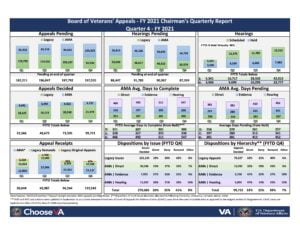Every quarter, the Board of Veterans Appeals publishes a report on the backlog of cases on their docket. This data can be used as a good guide for estimating how long an appeal will take once filed before the Board. Let’s take a look at the data:
First, before looking at these reports, it is important to provide a caveat. These are “average” numbers, and some files move a lot quicker for one reason or another.

BVA Quarterly Report Takeaways
There is some interesting data in this report. First, it looks like the BVA had a large increase in the number of hearings held, and a moderate increase in Appeals Decided, which is a good thing. This generally indicates that output is increasing, which would tend to indicate that processing speeds increase. However, we are not seeing that in the Average Days Pending is coming down. In fact, it is going up, but significant amounts in the Hearing and Evidence Submission lanes. On the other hand, the Direct Review Lane times are coming down.
Still, the average Direct Review docket cases are pending less than the one-year goal set by the BVA. As we said above, this might look like a good thing, but the number does not carry a ton weight. The Law Office of Andrew P. Gross is still seeing some Direct Review Lane cases pending at well-over the one-year mark.
Of note, the BVA just finished up a hiring spree for Veterans Law Judges, and will likely be adding more attorneys to assist the Veterans Law Judges in their decision-writing and output, which should help keep pace with the influx of cases coming in under the Appeals Modernization Act.
Either way, this is why it is very important to think strategically about how to appeal your VA Benefits decision, and which lane to choose.

